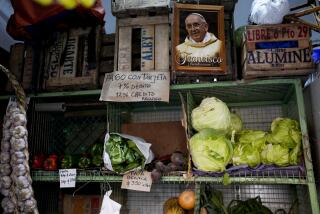National Agenda : Brazil Retooling for the ‘Forgotten’ Consumers : The middle class and even the poor are fueling the huge nation’s economic boom. Lower inflation and more stability are keys.
- Share via
SAO PAULO, Brazil — Brazil, said the conventional wisdom, was a big country endowed with vast riches and even vaster poverty. At the top sat the privileged few whose riches made the market go round. Just below was a thin middle class trying to hold on to what it had. At the bottom were the teeming masses, who had nothing but their dreams.
Now the economists are taking a second look. Though businesses are still poring over their year-end sales ledgers, the preliminary numbers are startling. Sales of consumer goods, from floor fans to Fiats, are booming. Supermarkets and butcher shops are full of customers. Factories are jammed with back orders.
And it is not only the rich who are mobbing the malls. Brazilians of modest and low incomes have gone on a binge, their fists full of Brazilian reals . Suddenly business leaders are paying attention to a class of consumers that they had long written off.
The reason for the buying spree is simple: stable prices. Last July, the Brazilian government launched an economic stabilization program, the real plan, named for the country’s strong new currency. Inflation, Brazil’s worst habit, was under control. Monthly inflation fell from 48.2% in June to 1.25% in December, still high by advanced economies but a remarkable achievement for price-fevered Brazil.
For years, while prices boiled, workers watched their wages melt away in their pockets virtually overnight. Economists call this the “inflation tax.” But in a matter of weeks last year, price stability injected an estimated $15 billion in new reals into the economy. Brazil went shopping.
Retail sales in Rio de Janeiro rose 50% in 1994, and shopping malls doubled their volume of business. Door-to-door and mail-order sales took off and are expected to soar this year, by 85% over 1994, according to the Brazilian Marketing Assn. Last year, 10 million television sets were sold, 8 million more than in 1993.
The rich are doing what they always have done, buying with abandon, and with trade barriers falling, they have been further enticed by imports, which are displacing high-priced Brazilian-made goods.
For decades, the economic principle in Latin America had been import substitution. When private capital was scarce or skittish, the government turned inward, looking to domestic companies to produce the basic stuff of an industrial society: steel, roads, ships, car parts and the like. The policy served Brazil well for a time. But it ended up creating a bell jar in which tender and inefficient industry sprouted and thrived in artificial comfort.
High duties on imports and non-tariff barriers kept the world away. Competition was held to a few domestic firms that produced for the wealthy few at exorbitant prices.
But those cushy days are over. Import tariffs have fallen from 38% on average to about 12%. Profit margins have fallen, and the wealthy have abandoned their locally made goods for cheaper imports.
Now that the fat times are over, what is the orphaned Brazilian industry to do?
Reinvent itself, many economists say. Ciro Gomes, a former finance minister, explained: “Brazil has manufactured everything from sugar cane to satellites. Now we have to sit down and think what do we do best, better than anyone else.”
The obvious solution: go down market.
“Just look at your client,” counsels Stephen Kanitz, a University of Sao Paulo economist. “Your client is poor. This is Brazil’s natural market, and no one knows how big it really is.”
It may be enormous. Nearly 80% of Brazilian workers earn less than $1,500 per month, including the 29% who earn less than $355 a month, according to Paulo Seeches, a sociologist. “These are people who spend up to 90% of their income on consumer goods, and yet they are very badly served.”
Consider Rio, a city of startling contrasts. The moneyed city is called the South Zone, necklaced by pearl white beaches and crowned by penthouses, stretching elegantly before the statue of Christ on Corcovado peak. Yet it is the shopper from the North Zone, a sprawl of shops, factories and working-class homes, that makes Rio’s economy turn. North Zone consumers generate about $55 per capita a year in sales taxes, against $36 in the South Zone.
Kanitz believes that the future of Brazilian industry means learning to make “popular goods.” The idea is not to “pauperize” goods but “debundle” them, creating bare-bones wares that may be upgraded with accessories for the more discerning customers: say, a simple television with the remote control as an extra.
“Brazil is dominated by bright young engineers who want the latest technology,” Kanitz says. “Brazilian companies don’t need re-engineering. What we need is basic engineering. Three-fourths of the world is poor. And once we learn to produce for them, Brazil will have the world at its feet.”
Literally, perhaps. Check out Grendene, Brazil’s biggest footwear company. Grendene was founded in the 1970s with the most modest feet in mind, specializing in “jellies,” or bargain-priced, adjustable plastic slippers. That prescience paid off. On the eve of the real plan, Marcius Dal Bo, Grendene’s president, had a hunch and expanded plant capacity by 25%. He sold everything: 80 million pairs of shoes and slippers.
To meet competition from abroad, Grendene tightened its costs and dropped its wholesale price from $5 a pair for the cheapest shoes to $2.70. Total sales grew to $600 million last year.
Emerson Kapaz, a Sao Paulo toy maker, long ago learned the value of the humble customer. His firm, Elka, sold 13 million toys last year, and “I could have sold 20 million if the factory was big enough.”
The secret: low costs and simplicity. “My most expensive toy is $15,” a gas station with all sorts of gears and mechanical gadgets, he says.
It is not only the poorest of the poor who have been buying. Two years ago, the Brazilian government awarded a tax break to car makers, leading to development of the “popular car,” priced around $7,000, and fitted with one-liter engines. A total of 1,582,900 of these simple economy cars were made last year, up from 914,000 in 1990. Suddenly the slipping middle class had wheels again.
Tending to the abandoned masses is not for everyone. Manufacturers moan that this means reinventing products, retooling factories, vastly boosting production and rethinking marketing strategy, all of which take time and money.
Many industries, such as car makers, are still crying for shelter against the import invasion. Others want special incentives and even bigger tax breaks.
Some of their litany makes sense. Kapaz, who heads the Sao Paulo state science and technology office, argues that pensions, taxes and high interest add 25% to 30% to the price of Brazilian consumer goods.
Yet howling for protection may do little good. Trade barriers are still falling. Imports now account for 20% of all retailing in Rio.
“The whole world is trying to figure out what it can do best. The sooner we find out what that is, the better off we’ll be,” Kapaz says.
More on Brazil
* Reprints are available from Times on Demand of “Government Wants to Teach Brazilians That if They Shop Till They Drop, Then Prices May Too,” a report on learning to cope without hyperinflation. Call 808-8463 and press *8630. Request item 6041. $2.
Details on Times electronic services, B4
(BEGIN TEXT OF INFOBOX / INFOGRAPHIC)
Dramatic Drop
Inflation slowed quickly after Brazil introduced a new economic plan in July, 1994.
1994 monthly inflation rate
Dec.: 1.25%
Sources: Official government index and Sao Paulo University index.
More to Read
Sign up for Essential California
The most important California stories and recommendations in your inbox every morning.
You may occasionally receive promotional content from the Los Angeles Times.












